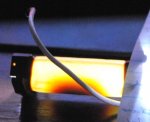P210 -- How many Joules is your PS putting out ? Voltage??
The SSY- 1 is a little hotter than the copy :-(
HMike
Wish I could measure the output but it is too fast.
Mike here is what I did to measure power (approximately). I took a 1/4 inch carbon rod and cut off a thin slice. I carefully ground that down and polished the back side. Then with further grinding on sand paper so that it was 50+/- 1 milligrams. Then I soldered a very small thermocouple to the polished back side with less than 1 mg of super glue. I put it in the laser path just past the lens so that the beam just covered the whole disk. I could detect no carbon ablation. Then I hit it with 10 laser shots in 10 seconds (the carbon disk does not cool significantly in that time) and measured the temperature rise.
Calculating the power in millijoules is then simple.
Here are my calculations:
So we have:
Q=C M (delta T)
Where Q = quantity of heat (calories)
C = specific heat of carbon
M= mass of sensor
T = temperature
Therefore 0.170 (C) * 0.050 (M) * 3.05 (delta T) = 0.0255 calories which is converted to joules by multiplying by 4.184 = .1067 which is divided by 10 because 10 shots were made = .01067. Converted to millijoules = 10.67. Which agrees well with the literature?
Update:
I found that above 750v even the unfocused beam vaporizes some carbon from the wafer so I am going to have to either attenuate the beam or get a larger rod. What I wouldn’t give for one those old No. 6 dry cell batteries.
Gee I hope my math was correct.
The biggest problem here was the resolution of the temp scale on my multimeter. The solution is to get a tiny thermistor and measure resistance then convert to temp.
It just occurred to me I should go back and repeat this measurement. That will tell me if I've lost significant power.









